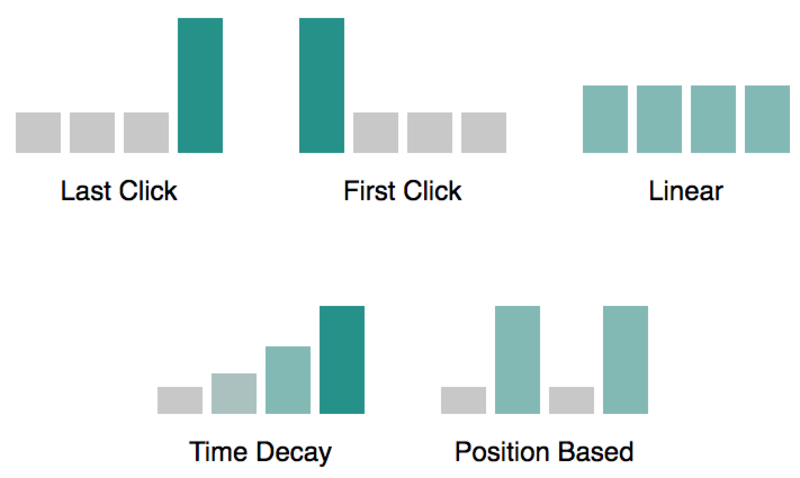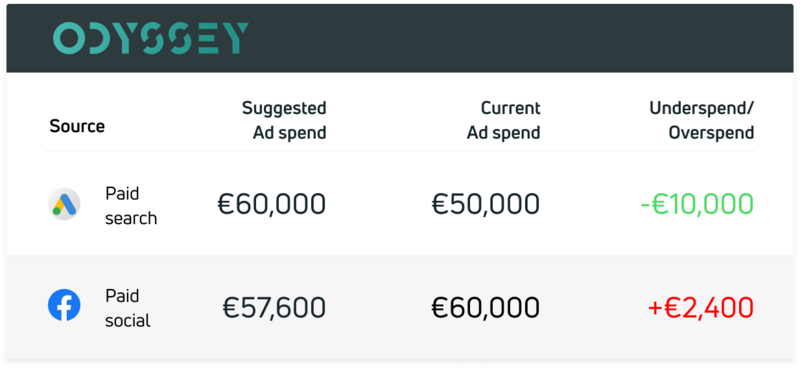How Odyssey uses Google Analytics as a tracking source
One of the biggest benefits of Odyssey Attribution is that we are able to extract the raw data from Google Analytics. How, you are asking? Let us explain
Even though marketing attribution isn’t the newest thing, it’s still relatively unknown in the marketing landscape. No worries, we’re here to get you up to date on this revenue increasing way of looking at your marketing strategy.
Understanding the steps a customer takes, before converting is very valuable information for any marketer or advertiser.
Marketing Attribution is a way of crediting traffic sources for their effort. In order to provide you with a clear understanding of marketing attribution, it’s best to use a simple example:
Now, you could say that that sale is made thanks to the display ad. That’s what most, last-click focused attribution models do. But proper attribution looks further than that. Because Michael’s customer journey could have looked like this:
In this example, Michael has visited the Sneakers Sports Store four times, before buying the sneakers during his fifth visit. In his customer journey, Michael has been sent to the Sneakers Sports Store by four different traffic sources; (1) blog, (2) paid search, (3) paid social and (4) display retargeting.
As a marketer, you now want to point a finger to which of these traffic sources is responsible for that sale. Or at least, which of these traffic sources is most important. That’s where marketing attribution comes in.
With marketing attribution, marketers can see which traffic sources are most valuable for them. Therefore, marketing attribution can be used to allocate marketing budgets better, and increase revenue.
Being a marketer or advertiser these days is hard. There’s a lot of competition out there, so you’re working hard to make sure your marketing efforts are resulting in more sales, and so more profit.
Therefore, you’re probably using several marketing channels, to send traffic to your website. You probably run a Google Paid Search Account, do some social advertising on Facebook and Instagram and maybe you even do a retargeting display campaign.
With all those traffic sources, you might be having some difficulty identifying the most valuable marketing channels. Furthermore, what data should you rely on? Every traffic source is doing its own analytics.
So, in order to get a clear overview of the effectiveness of your marketing efforts, you are looking for a system to get this. Without a lot of installation and expensive software. That is where Marketing Attribution Tools come in.
So, when looking at the previous example of Michael buying his new sneakers; the next challenge is to determine which of those traffic sources is most important in that customer journey.
In order to do that, different attribution models are available. An attribution model is basically a calculation to determine which touchpoint will be credited for a sale.
A distinction can be made between single click attribution and multi-click attribution. Single click attribution credits one touchpoint (mostly the first or the last) for a sale. Multi-click attributes value to several touchpoints.
Below some of the most common attribution models:
Choosing a marketing attribution model is a complex and difficult task. And to be honest, there is no perfect attribution model. There is no one size fits all. Every organization is in a unique position and therefore, needs to look differently at their marketing attribution modeling.
Even more important than choosing the right attribution model, is using attribution consistently and transform data into actionable insights.
When marketing attribution is done right, you’ll collect a lot of interesting data. But, analyzing the data in a correct way is just as important as collecting the data itself. There are a couple of things you want to keep into account when analyzing your data:
When looking at your attribution data, you want to be able to compare data at every possible level. For example, you want to be able to compare paid search vs affiliate, but also compare keyword X vs. keyword Y.
When analyzing marketing attribution data, it’s once again very important that a marketer is analyzing from the company’s view. What are the current goals, who are the customers we’re trying to reach, etc? As mentioned before, your company’s goals should be in line with your strategy.
Optimize before you stop
Analyzing your attribution data may result in the insight of some very poorly performing traffic sources. This may make you consider to stop using these traffic sources completely, in order to save money quickly.
But in reality, it’s almost always better to first check if you can optimize the traffic source.
For example, if your attribution analysis resulted in the outcome that affiliate X is performing very poorly. Instead of terminating your relationship with affiliate X; use the data to start the conversation. Tell affiliate X you’ve got a better view of your data and you noticed their poor performance. Tell them you’re giving them an opportunity to improve and let them know what you would like to see from them.
Another example could be a display campaign. If your Google Analytics data used to make you think that this source was performing very well, and now you see that is doesn’t, you should optimize the campaign and analyze the attribution data.
Click here to read more about using common sense in attribution.
The customer journey is the key thing to understand when it comes to marketing attribution. The customer journey is the route someone travels, before making a certain action on your website. The example of Michael buying sneakers mentioned before is an example of a customer journey.
In the current marketing landscape, more and more different traffic sources are part of customer journeys. Where the landscape used to be dominated by direct and search traffic, nowadays many different traffic sources can be identified.
In general, these are the ten groups of main traffic sources:
Within a customer journey, a customer goes through different phases. In the beginning of his journey he’s mainly considering different brands and at the end of his journey, the customer is more focused on choosing one (Mckinsey, 2015).
It’s been mentioned a couple times now, but remember; marketing attribution (strategy) is different for everyone. Therefore, it’s very important for an advertiser to have a critical look when coming up with an attribution strategy.
A couple of questions to ask yourself when creating your attribution strategy are:
Even though there is no one size fits all, some basics can be used for the foundation of your attribution strategy:
With these basics, you should take a closer look at your situation. Answer the questions and ask yourself more questions. make sure you have a critical and well-thought-out idea of your marketing attribution strategy.
The current market of marketing attribution is still facing some problems. But they shouldn’t be in the way of smart marketers, wanting to implement marketing attribution correctly. Read about the problems so you know how to tackle them:
Many companies (even large enterprises) are still using a last-click attribution model. And why? Most of the time the answer is simply because that’s the default. As mentioned before last click is outdated.
Dependent and intransparent tools are still being trusted by marketers. Google Analytics for example (how likely do you think it would be that Google Analytics would show you insights that are favoring other traffic sources like Facebook over Google?). And that should be changed. Smart marketers know that they need data that is transparent and independent. That’s the only way they can make reliable decisions.
A great example of why you should use an independent and transparent tool is the well-known problem of Facebook Ads and Google Analytics data not matching. Many marketers will be aware of this problem. The, sometimes extremely large, discrepancies, between Facebook and Google data.
Sometimes this has to do with Google and Facebook having the same names for different metrics. Therefore, it gives you, as a marketer, a wrong image of the data. Besides, both Facebook and Google use very different attribution modeling.
But in other cases, the discrepancy is hard to clarify. The differences in data makes the job of marketers more difficult. Therefore, marketers should use an independent and transparent attribution tool.
When working with attribution, you’ll get to know some new metrics. We’re here to provide you with an overview of some of those metrics.
| Metric | Meaning |
|---|---|
| Single-Touch | Single touch is being used for attribution models that only credit one touchpoint in the customer journey for the event or sale. Examples are first click and last click. |
| Multi-touch | Multi-touch is being used for attribution models that credit multiple touchpoints in the customer journey for the event or sale. Examples are linear and time decay. |
| Incrementality | Incrementality is the extent to which a sale can be attributed to a specific traffic source expressed as a percentage |
| Customer Journey | The path a customer follows before he/she converts (consisting of one or multiple touchpoints) |
| Touchpoint | A touchpoint is a point within the customer journey, represented by the traffic source a visitor to the advertisers’ originates from (for example Facebook). |
| Traffic Source | A digital source that leads visitors (generates traffic) to the advertisers’ website (through ads, links, etc.). |
| Customer Journey Lenght in Clicks | The length in clicks is a metric that can be used for attribution modeling and represents the average number of touchpoints within a customer journey of which the respective traffic source is a part of. |
| Customer Journey Lenght in Days | The length in days is a metric that can be used for attribution modeling and represents the average amount of days in the customer journey of which this traffic source is a part of. |
| Customer Journey | Density is the market share within a customer journey, expressed as a percentage. |
| Customer Journey Position | The customer journey position is a metric that can be used for attribution modeling and represents the average position of a traffic source within the customer journey. |
How Odyssey uses Google Analytics as a tracking source
One of the biggest benefits of Odyssey Attribution is that we are able to extract the raw data from Google Analytics. How, you are asking? Let us explain
What if we could re-start affiliate marketing?
The lack of a proper attribution model within the industry is actually more or less how we got to the first version of Odyssey. However, there are more topics in which I believe the affiliate industry is completely missing the point.
How to include costs and revenue in your attribution model?
It's important to see which marketing channels drive most of the value, but if these channels cost you a fortune, you don't want to spend all your marketing budget there. Therefore, including both costs and revenue in your MTA model is essential.




